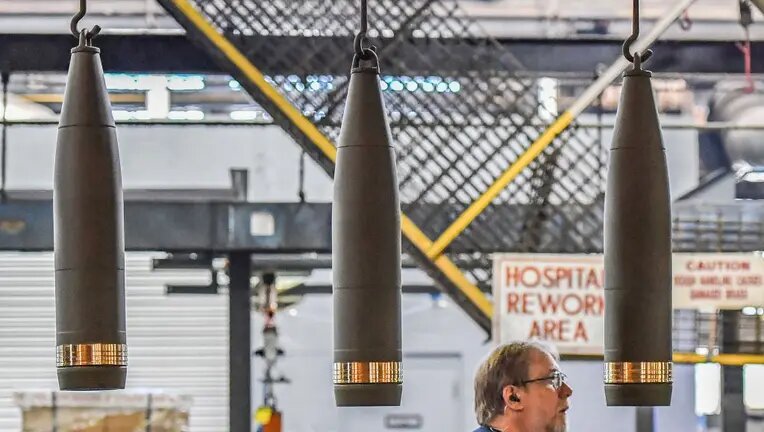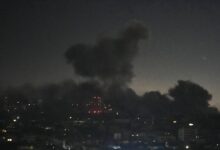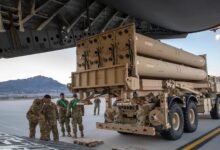Unprepared For Extended Battle, US Army Under Gun To More Munitions

- Once the shells are done in Scranton, they are sent to the Iowa Army Ammunition Plant, where they are filled with explosives, given fuses
- The Scranton plant isn't the best place to do that job, because an accident involving an explosion could be very bad.
One of the most important weapons in the Ukraine war comes from a historic plant in this city that was built by coal barons. Tons of steel rods are brought in by train to be forged into artillery shells that Kyiv can’t get enough of and that the U.S. can’t make fast enough.
The Scranton Army Ammunition Plant is at the front of a multibillion-dollar Pentagon plan to upgrade and speed up the production of ammunition and equipment, both to help Ukraine and to be ready for a possible war with China.
But it is one of only two places in the U.S. that makes the steel bodies for the important 155 mm howitzer rounds that the U.S. is sending to Ukraine to help fight off the Russian attack in the biggest war in Europe since World War II.
The invasion of Ukraine showed that the U.S. and its European allies did not have enough 155 mm shells to support a big, ongoing conventional land war. This made them scramble to increase production. Planners in the U.S. military are worried about the shrinking supply, so the Army plans to spend billions on weapons plants across the country in what it calls its biggest change in 40 years.
It might not be easy to change. Almost every square foot of the red brick factory buildings at the Scranton plant, which were built more than a century ago as a place to fix locomotives, is in use as the Army clears space, moves production to private factories, and puts together new supply lines.
Some things are kept secret by the Army and plant officials in Scranton, like where the steel for the shells comes from and how many more rounds this factory can make.
“That’s what Russia wants to know,” Justine Barati of the Joint Munitions Command of the U.S. Army said.
So far, the U.S. has given Ukraine weapons and other gear worth more than $35 billion.
Along with air defense systems, long-range missiles, and tanks, the 155 mm shell is one of the most-requested and-provided things.
The rounds, which are used in howitzer systems, are very important to Ukraine’s fight because they let the Ukrainians hit Russian targets up to 20 miles (32 kilometers) away with a highly powerful bomb.
“Unfortunately, we know that production is very low and that the war has been going on for more than a year,” Oleksandra Ustinova, a member of the Ukrainian parliament, said Monday at a German Marshall Fund media meeting in Washington. “But 155 is a very important part of our lives.”
U.S. Army Undersecretary Gabe Camarillo told a symposium last month that the Army is spending about $1.5 billion to increase production of 155 mm rounds from 14,000 a month before Russia attacked Ukraine to over 85,000 a month by 2028.
Army records show that the U.S. military has already given Ukraine more than 1.5 million rounds of 155 mm ammo.
But even if production rates go up in the near future, the U.S. won’t be able to fill up its stockpile or catch up to the rate of use in Ukraine, where sources say the military fires between 6,000 and 8,000 shells per day. In other words, the amount of shells fired by Ukraine in two days is the same as what the US made in a month before the war.
“This could get out of hand. The front line is now mostly still, so artillery has become the most important fighting force, according to a study from the Center for Strategic and International Studies in Washington in January.
At the moment, the aluminum bodies for the 155 mm shells are made at the Army’s plant in Scranton, which is run by General Dynamics, and at a plant in Wilkes-Barre that is also owned by General Dynamics.
Together, the plants have a deal to make 24,000 shells per month. The Army has also given the plants a $217 million task order to increase production even more, but officials won’t say how many more 155 mm shells are needed.
Ustinova, who is on Ukraine’s wartime oversight group, said that the Russians fire 40,000 shells every day.
“So we do five times less than they do and try to keep up the same pace. But if we don’t start the production lines and warm it up, it will be a big problem,” Ustinova said.
At the Scranton plant, you can see how hard it is for the U.S. to speed up production.
The factory was built for the Delaware, Lackawanna and Western Railroad right after 1900, when the city was becoming a coal and railroad force. Since the Korean War, the factory has been making large-caliber ammunition for the military.
But because the buildings are on the National Historic Registry of Historic Places, the Army is limited in how it can change them.
Inside, the floor is full of stacks of shells, broken equipment, and production lines where robotic arms, saws, presses, and other tools cut, heat, forge, temper, pressure test, wash, and paint the shells.
The plant is getting updated with the help of $120 million, and the Army hopes to open a new line of production there by 2025.
Still, it’s been hard to make room for it while the military adds new equipment to old lines to make them work better.
“There’s a lot going on,” Army commander’s spokesman Richard Hansen said at the plant.
In the meantime, the Army is building up supply lines for metal shells, explosive fill, charges that fire the shell, and fuses, and buying the big machines that do the work.
Douglas Bush, an assistant Army secretary and the Army’s top arms buyer, said that the Army has signed new contracts with factories in Texas and Canada to make 155 mm shells. Bush said that the U.S. is also looking to its allies abroad to help it increase output.
Once the shells are done in Scranton, they are sent to the Iowa Army Ammunition Plant, where they are filled with explosives, given fuses, and put in boxes to be sent to their final destination.
The Scranton plant isn’t the best place to do that job, because an accident involving an explosion could be very bad.
Hansen said, “If something went wrong here, we’d take half the city with us.”







Facebook Comments